`pydbm` is Python library for building Restricted Boltzmann Machine(RBM), Deep Boltzmann Machine(DBM), Recurrent neural network Restricted Boltzmann Machine(RNN-RBM), LSTM Recurrent Temporal Restricted Boltzmann Machine(LSTM-RTRBM), and Shape Boltzmann Machine(Shape-BM).
Project description
Deep Learning Library: pydbm
pydbm is Python library for building Restricted Boltzmann Machine(RBM), Deep Boltzmann Machine(DBM), Long Short-Term Memory Recurrent Temporal Restricted Boltzmann Machine(LSTM-RTRBM), and Shape Boltzmann Machine(Shape-BM).
This is Cython version. pydbm_mxnet (MXNet version) is derived from this library.
Documentation
Full documentation is available on https://code.accel-brain.com/Deep-Learning-by-means-of-Design-Pattern/ . This document contains information on functionally reusability, functional scalability and functional extensibility.
Installation
Install using pip:
pip install pydbm
Or, you can install from wheel file.
pip install https://storage.googleapis.com/accel-brain-code/Deep-Learning-by-means-of-Design-Pattern/pydbm-{X.X.X}-cp36-cp36m-linux_x86_64.whl
Source code
The source code is currently hosted on GitHub.
Python package index(PyPI)
Installers for the latest released version are available at the Python package index.
Dependencies
- numpy: v1.13.3 or higher.
- cython: v0.27.1 or higher.
Description
The function of pydbm is building and modeling Restricted Boltzmann Machine(RBM) and Deep Boltzmann Machine(DBM). The models are functionally equivalent to stacked auto-encoder. The basic function is the same as dimensions reduction(or pre-training). And this library enables you to build many functional extensions from RBM and DBM such as Recurrent Temporal Restricted Boltzmann Machine(RTRBM), Recurrent Neural Network Restricted Boltzmann Machine(RNN-RBM), Long Short-Term Memory Recurrent Temporal Restricted Boltzmann Machine(LSTM-RTRBM), and Shape Boltzmann Machine(Shape-BM).
As more usecases, RTRBM, RNN-RBM, and LSTM-RTRBM can learn dependency structures in temporal patterns such as music, natural sentences, and n-gram. RTRBM is a probabilistic time-series model which can be viewed as a temporal stack of RBMs, where each RBM has a contextual hidden state that is received from the previous RBM and is used to modulate its hidden units bias. The RTRBM can be understood as a sequence of conditional RBMs whose parameters are the output of a deterministic RNN, with the constraint that the hidden units must describe the conditional distributions. This constraint can be lifted by combining a full RNN with distinct hidden units. In terms of this possibility, RNN-RBM and LSTM-RTRBM are structurally expanded model from RTRBM that allows more freedom to describe the temporal dependencies involved.
The usecases of Shape-BM are image segmentation, object detection, inpainting and graphics. Shape-BM is the model for the task of modeling binary shape images, in that samples from the model look realistic and it can generalize to generate samples that differ from training examples.

Image in the Weizmann horse dataset. |
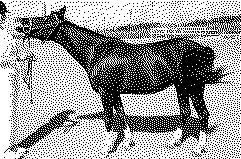
Binarized image. |
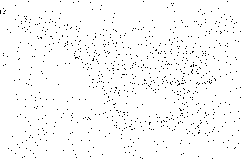
Reconstructed image by Shape-BM. |
The structure of RBM.
According to graph theory, the structure of RBM corresponds to a complete bipartite graph which is a special kind of bipartite graph where every node in the visible layer is connected to every node in the hidden layer. The state of this structure can be reflected by the energy function:

where 




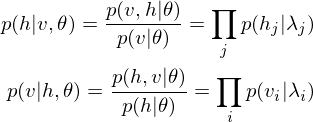
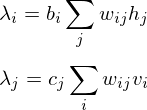
The learning equations of RBM.
Because of the rules of conditional independence, the learning equations of RBM can be introduced as simple form. The distribution of visible state 


where 






where 


The learning equations of RBM are introduced by performing control so that those gradients can become zero.

Contrastive Divergence as an approximation method.
In relation to RBM, Contrastive Divergence(CD) is a method for approximation of the gradients of the log-likelihood. The procedure of this method is similar to Markov Chain Monte Carlo method(MCMC). However, unlike MCMC, the visbile variables to be set first in visible layer is not randomly initialized but the observed data points in training dataset are set to the first visbile variables. And, like Gibbs sampler, drawing samples from hidden variables and visible variables is repeated k times. Empirically (and surprisingly), k is considered to be 1.
The structure of DBM.

Salakhutdinov, R., Hinton, G. E. (2009). Deep boltzmann machines. In International conference on artificial intelligence and statistics (pp. 448-455). p451.
As is well known, DBM is composed of layers of RBMs stacked on top of each other. This model is a structural expansion of Deep Belief Networks(DBN), which is known as one of the earliest models of Deep Learning. Like RBM, DBN places nodes in layers. However, only the uppermost layer is composed of undirected edges, and the other consists of directed edges. DBN with R hidden layers is below probabilistic model:

where r = 0 points to visible layer. Considerling simultaneous distribution in top two layer,

and conditional distributions in other layers are as follows:

The pre-training of DBN engages in a procedure of recursive learning in layer-by-layer. However, as you can see from the difference of graph structure, DBM is slightly different from DBN in the form of pre-training. For instance, if r = 1, the conditional distribution of visible layer is
 .
.On the other hand, the conditional distribution in the intermediate layer is

where 2 has been introduced considering that the intermediate layer r receives input data from Shallower layer
r-1 and deeper layer r+1. DBM sets these parameters as initial states.
DBM as a Stacked Auto-Encoder.
DBM is functionally equivalent to a Stacked Auto-Encoder, which is-a neural network that tries to reconstruct its input. To encode the observed data points, the function of DBM is as linear transformation of feature map below
 .
.On the other hand, to decode this feature points, the function of DBM is as linear transformation of feature map below
 .
.The reconstruction error should be calculated in relation to problem setting. This library provides a default method, which can be overridden, for error function that computes Mean Squared Error(MSE).
Structural expansion for RTRBM.
The RTRBM (Sutskever, I., et al. 2009) is a probabilistic time-series model which can be viewed as a temporal stack of RBMs, where each RBM has a contextual hidden state that is received from the previous RBM and is used to modulate its hidden units bias. Let 
t-1. The conditional distribution in hidden layer in time t is

where 

While the hidden units are binary during inference and sampling, it is the mean-field value 

Structural expansion for RNN-RBM.
The RTRBM can be understood as a sequence of conditional RBMs whose parameters are the output of a deterministic RNN, with the constraint that the hidden units must describe the conditional distributions and convey temporal information. This constraint can be lifted by combining a full RNN with distinct hidden units. RNN-RBM (Boulanger-Lewandowski, N., et al. 2012), which is the more structural expansion of RTRBM, has also hidden units 
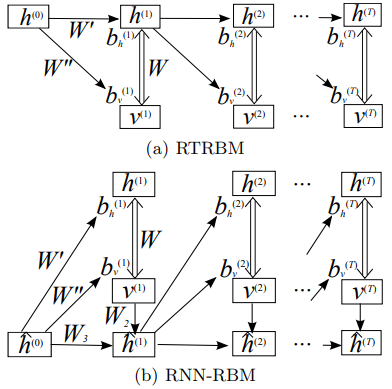
Boulanger-Lewandowski, N., Bengio, Y., & Vincent, P. (2012). Modeling temporal dependencies in high-dimensional sequences: Application to polyphonic music generation and transcription. arXiv preprint arXiv:1206.6392., p4.
Single arrows represent a deterministic function, double arrows represent the stochastic hidden-visible connections of an RBM.
The biases are linear function of 

t by the relation:

where 

Structural expansion for LSTM-RTRBM.
An example of the application to polyphonic music generation(Lyu, Q., et al. 2015) clued me in on how is it possible to connect RTRBM with LSTM.
Structure of LSTM.
Originally, Long Short-Term Memory(LSTM) networks as a special RNN structure has proven stable and
powerful for modeling long-range dependencies. The Key point of structural expansion is its memory cell 







Omitting so-called peephole connection, it makes possible to combine the activations in LSTM gates into an affine transformation below.

where 





and the acitivation of memory cell and hidden units are calculated as follows:


Structure of LSTM-RTRBM.
LSTM-RTRBM model integrates the ability of LSTM in memorizing and retrieving useful history information, together with the advantage of RBM in high dimensional data modelling. Like RTRBM, LSTM-RTRBM also has the recurrent hidden units. Let 

where 


"Adding LSTM units to RTRBM is not trivial, considering RTRBM’s hidden units and visible units are intertwined in inference and learning. The simplest way to circumvent this difficulty is to use bypass connections from LSTM units to the hidden units besides the existing recurrent connections of hidden units, as in LSTM-RTRBM."
Therefore it is useful to introduce a distinction of channel which means the sequential information. 





Structural expansion for Shape-BM.
The concept of Shape Boltzmann Machine (Eslami, S. A., et al. 2014) provided inspiration to this library. This model uses below has two layers of hidden variables: 

v arethe pixels of a binary image of size 





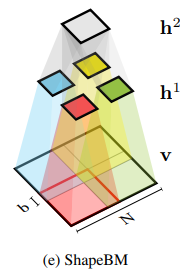
Eslami, S. A., Heess, N., Williams, C. K., & Winn, J. (2014). The shape boltzmann machine: a strong model of object shape. International Journal of Computer Vision, 107(2), 155-176., p156. |
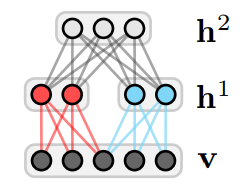
Eslami, S. A., Heess, N., Williams, C. K., & Winn, J. (2014). The shape boltzmann machine: a strong model of object shape. International Journal of Computer Vision, 107(2), 155-176., p156. |
The Shape-BM is a DBM in three layer. The learning algorithm can be completed by optimization of

where 
The commonality/variability analysis in order to practice object-oriented design.
From perspective of commonality/variability analysis in order to practice object-oriented design, the concepts of RBM and DBM paradigms can be organized as follows.
While each model is common in that it is constituted by stacked RBM, its approximation methods and activation functions are variable depending on the problem settings. Considering the commonality, it is useful to design based on Builder Pattern, which separates the construction of RBM object from its representation so that the same construction process can create different representations such as DBM, RTRBM, RNN-RBM, and Shape-BM. On the other hand, to deal with the variability, Strategy Pattern, which provides a way to define a family of algorithms such as approximation methods and activation functions, is useful design method, which is encapsulate each one as an object, and make them interchangeable from the point of view of functionally equivalent.
Functionally equivalent: Encoder/Decoder based on LSTM.
The methodology of equivalent-functionalism enables us to introduce more functional equivalents and compare problem solutions structured with different algorithms and models in common problem setting. For example, in dimension reduction problem, the function of Encoder/Decoder schema is equivalent to DBM as a Stacked Auto-Encoder.
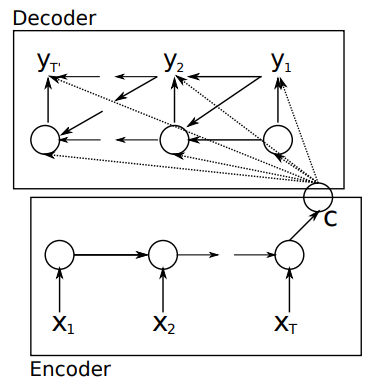
Cho, K., Van Merriënboer, B., Gulcehre, C., Bahdanau, D., Bougares, F., Schwenk, H., & Bengio, Y. (2014). Learning phrase representations using RNN encoder-decoder for statistical machine translation. arXiv preprint arXiv:1406.1078., p2.
According to the neural networks theory, and in relation to manifold hypothesis, it is well known that multilayer neural networks can learn features of observed data points and have the feature points in hidden layer. High-dimensional data can be converted to low-dimensional codes by training the model such as Stacked Auto-Encoder and Encoder/Decoder with a small central layer to reconstruct high-dimensional input vectors. This function of dimensionality reduction facilitates feature expressions to calculate similarity of each data point.
This library provides Encoder/Decoder based on LSTM, which is a reconstruction model and makes it possible to extract series features embedded in deeper layers. The LSTM encoder learns a fixed length vector of time-series observed data points and the LSTM decoder uses this representation to reconstruct the time-series using the current hidden state and the value inferenced at the previous time-step.
Functionally equivalent: Convolutional Auto-Encoder.
Shape-BM is a kind of problem solution in relation to problem settings such as image segmentation, object detection, inpainting and graphics. In this problem settings, Convolutional Auto-Encoder(Masci, J., et al., 2011) is a functionally equivalent of Shape-BM. A stack of Convolutional Auto-Encoder forms a convolutional neural network(CNN), which are among the most successful models for supervised image classification. Each Convolutional Auto-Encoder is trained using conventional on-line gradient descent without additional regularization terms.

Image in the Weizmann horse dataset. |

Reconstructed image by Shape-BM. |
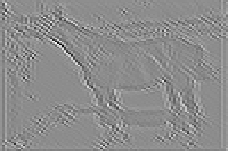
Reconstructed image by Convolutional Auto-Encoder. |
This library can draw a distinction between Stacked Auto-Encoder and Convolutional Auto-Encoder, and is able to design and implement respective models. Stacked Auto-Encoder ignores the 2 dimentional image structures. In many cases, the rank of observed tensors extracted from image dataset is more than 3. This is not only a problem when dealing with realistically sized inputs, but also introduces redundancy in the parameters, forcing each feature to be global. Like Shape-BM, Convolutional Auto-Encoder differs from Stacked Auto-Encoder as their weights are shared among all locations in the input, preserving spatial locality. Hence, the reconstructed image data is due to a linear combination of basic image patches based on the latent code.
In this library, Convolutional Auto-Encoder is also based on Encoder/Decoder scheme. The encoder is to the decoder what the Convolution is to the Deconvolution. The Deconvolution also called transposed convolutions "work by swapping the forward and backward passes of a convolution." (Dumoulin, V., & Visin, F. 2016, p20.)
Usecase: Building the deep boltzmann machine for feature extracting.
Import Python and Cython modules based on Builder Pattern.
# The `Client` in Builder Pattern
from pydbm.dbm.deep_boltzmann_machine import DeepBoltzmannMachine
# The `Concrete Builder` in Builder Pattern.
from pydbm.dbm.builders.dbm_multi_layer_builder import DBMMultiLayerBuilder
# Contrastive Divergence for function approximation.
from pydbm.approximation.contrastive_divergence import ContrastiveDivergence
Import Python and Cython modules of activation functions.
# Logistic Function as activation function.
from pydbm.activation.logistic_function import LogisticFunction
# Tanh Function as activation function.
from pydbm.activation.tanh_function import TanhFunction
# ReLu Function as activation function.
from pydbm.activation.relu_function import ReLuFunction
Import Python and Cython modules of optimizers, and instantiate the objects.
# Stochastic Gradient Descent(SGD) as optimizer.
from pydbm.optimization.optparams.sgd import SGD as FirstSGD
from pydbm.optimization.optparams.sgd import SGD as SecondSGD
# is-a `OptParams`.
first_optimizer = FirstSGD()
# is-a `OptParams`.
second_optimizer = SecondSGD()
If you want to use not Stochastic Gradient Descent(SGD) but Adam optimizer, import Adam and instantiate it.
# Adam as a optimizer.
from pydbm.optimization.optparams.adam import Adam as FirstAdam
from pydbm.optimization.optparams.adam import Adam as SecondAdam
# is-a `OptParams`.
first_optimizer = FirstSGD()
# is-a `OptParams`.
second_optimizer = SecondSGD()
Setup parameters of regularization. For instance, the probability of dropout can be set as follows.
first_optimizer.dropout_rate = 0.5
second_optimizer.dropout_rate = 0.5
Instantiate objects and call the method.
# Contrastive Divergence for visible layer and first hidden layer.
first_cd = ContrastiveDivergence(opt_params=first_optimizer)
# Contrastive Divergence for first hidden layer and second hidden layer.
second_cd = ContrastiveDivergence(opt_params=second_optimizer)
# DBM
dbm = DeepBoltzmannMachine(
DBMMultiLayerBuilder(),
# Dimention in visible layer, hidden layer, and second hidden layer.
[train_arr.shape[1], 10, train_arr.shape[1]],
# Setting objects for activation function.
[ReLuFunction(), LogisticFunction(), TanhFunction()],
# Setting the object for function approximation.
[first_cd, second_cd],
# Setting learning rate.
learning_rate=0.05
)
# Execute learning.
dbm.learn(
train_arr,
# If approximation is the Contrastive Divergence, this parameter is `k` in CD method.
training_count=1,
# Batch size in mini-batch training.
batch_size=200,
# if `r_batch_size` > 0, the function of `dbm.learn` is a kind of reccursive learning.
r_batch_size=-1
)
If you do not want to execute the mini-batch training, the value of batch_size must be -1. And r_batch_size is also parameter to control the mini-batch training but is refered only in inference and reconstruction. If this value is more than 0, the inferencing is a kind of reccursive learning with the mini-batch training.
And the feature points can be extracted by this method.
feature_point_arr = dbm.get_feature_point(layer_number=1)
Usecase: Extracting all feature points for dimensions reduction(or pre-training)
Import Python and Cython modules.
# `StackedAutoEncoder` is-a `DeepBoltzmannMachine`.
from pydbm.dbm.deepboltzmannmachine.stacked_auto_encoder import StackedAutoEncoder
# The `Concrete Builder` in Builder Pattern.
from pydbm.dbm.builders.dbm_multi_layer_builder import DBMMultiLayerBuilder
# Contrastive Divergence for function approximation.
from pydbm.approximation.contrastive_divergence import ContrastiveDivergence
# Logistic Function as activation function.
from pydbm.activation.logistic_function import LogisticFunction
# Stochastic Gradient Descent(SGD) as optimizer.
from pydbm.optimization.optparams.sgd import SGD as FirstSGD
from pydbm.optimization.optparams.sgd import SGD as SecondSGD
# The function of reconsturction error.
from pydbm.loss.mean_squared_error import MeanSquaredError
Instantiate objects and call the method.
# is-a `OptParams`.
first_optimizer = FirstSGD()
# is-a `OptParams`.
second_optimizer = SecondSGD()
# The probability of dropout.
first_optimizer.dropout_rate = 0.5
second_optimizer.dropout_rate = 0.5
# Contrastive Divergence for visible layer and first hidden layer.
first_cd = ContrastiveDivergence(opt_params=first_optimizer, computable_loss=MeanSquaredError())
# Contrastive Divergence for first hidden layer and second hidden layer.
second_cd = ContrastiveDivergence(opt_params=second_optimizer, computable_loss=MeanSquaredError())
# Setting objects for activation function.
activation_list = [LogisticFunction(), LogisticFunction(), LogisticFunction()]
# Setting the object for function approximation.
approximaion_list = [first_cd, second_cd]
# is-a `DeepBoltzmannMachine`.
dbm = StackedAutoEncoder(
DBMMultiLayerBuilder(),
[target_arr.shape[1], 10, target_arr.shape[1]],
activation_list,
approximaion_list,
learning_rate=0.05 # Setting learning rate.
)
# Execute learning.
dbm.learn(
target_arr,
1, # If approximation is the Contrastive Divergence, this parameter is `k` in CD method.
batch_size=200, # Batch size in mini-batch training.
r_batch_size=-1 # if `r_batch_size` > 0, the function of `dbm.learn` is a kind of reccursive learning.
)
The function of computable_loss is computing the reconstruction error. MeanSquaredError is-a ComputableLoss, which is so-called Loss function.
Extract reconstruction error rate.
You can check the reconstruction error rate. During the approximation of the Contrastive Divergence, the mean squared error(MSE) between the observed data points and the activities in visible layer is computed as the reconstruction error rate.
Call get_reconstruct_error_arr method as follow.
reconstruct_error_arr = dbm.get_reconstruct_error_arr(layer_number=0)
layer_number corresponds to the index of approximaion_list. And reconstruct_error_arr is the np.ndarray of reconstruction error rates.
Extract the result of dimention reduction
And the result of dimention reduction can be extracted by this property.
pre_trained_arr = dbm.feature_points_arr
Extract weights obtained by pre-training.
If you want to get the pre-training weights, call get_weight_arr_list method.
weight_arr_list = dbm.get_weight_arr_list()
weight_arr_list is the list of weights of each links in DBM. weight_arr_list[0] is 2-d np.ndarray of weights between visible layer and first hidden layer.
Extract biases obtained by pre-training.
Call get_visible_bias_arr_list method and get_hidden_bias_arr_list method in the same way.
visible_bias_arr_list = dbm.get_visible_bias_arr_list()
hidden_bias_arr_list = dbm.get_hidden_bias_arr_list()
visible_bias_arr_list and hidden_bias_arr_list are the list of biases of each links in DBM.
Transfer learning in DBM.
DBMMultiLayerBuilder can be given weight_arr_list, visible_bias_arr_list, and hidden_bias_arr_list obtained by pre-training.
dbm = StackedAutoEncoder(
DBMMultiLayerBuilder(
# Setting pre-learned weights matrix.
weight_arr_list,
# Setting pre-learned bias in visible layer.
visible_bias_arr_list,
# Setting pre-learned bias in hidden layer.
hidden_bias_arr_list
),
[next_target_arr.shape[1], 10, next_target_arr.shape[1]],
activation_list,
approximaion_list,
# Setting learning rate.
0.05,
# Setting dropout rate.
0.0
)
# Execute learning.
dbm.learn(
next_target_arr,
1, # If approximation is the Contrastive Divergence, this parameter is `k` in CD method.
batch_size=200, # Batch size in mini-batch training.
r_batch_size=-1 # if `r_batch_size` > 0, the function of `dbm.learn` is a kind of reccursive learning.
)
Performance
Run a program: test/demo_stacked_auto_encoder.py
time python test/demo_stacked_auto_encoder.py
The result is follow.
real 1m59.875s
user 1m30.642s
sys 0m29.232s
Detail
This experiment was performed under the following conditions.
Machine type
- vCPU:
2 - memory:
8GB - CPU Platform: Intel Ivy Bridge
Observation Data Points
The observated data is the result of np.random.normal(loc=0.5, scale=0.2, size=(10000, 10000)).
Number of units
- Visible layer:
10000 - hidden layer(feature point):
10 - hidden layer:
10000
Activation functions
- visible: Logistic Function
- hidden(feature point): Logistic Function
- hidden: Logistic Function
Approximation
- Contrastive Divergence
Hyper parameters
- Learning rate:
0.05 - Dropout rate:
0.5
Feature points
[[0.092057 0.08856277 0.08699257 ... 0.09167331 0.08937846 0.0880063 ]
[0.09090537 0.08669612 0.08995347 ... 0.08641837 0.08750935 0.08617442]
[0.10187259 0.10633451 0.10060372 ... 0.10170306 0.10711189 0.10565192]
...
[0.21540273 0.21737737 0.20949192 ... 0.20974982 0.2208562 0.20894371]
[0.30749327 0.30964707 0.2850683 ... 0.29191507 0.29968456 0.29075691]
[0.68022984 0.68454348 0.66431651 ... 0.67952715 0.6805653 0.66243178]]
Reconstruct error
[ 0.11668085 0.07513545 0.091044 ..., 0.0719339 0.07976882 0.09121697]
Usecase: Building the RTRBM for recursive learning.
Import Python and Cython modules.
# `Builder` in `Builder Patter`.
from pydbm.dbm.builders.rt_rbm_simple_builder import RTRBMSimpleBuilder
# RNN and Contrastive Divergence for function approximation.
from pydbm.approximation.rt_rbm_cd import RTRBMCD
# Logistic Function as activation function.
from pydbm.activation.logistic_function import LogisticFunction
# Softmax Function as activation function.
from pydbm.activation.softmax_function import SoftmaxFunction
# Stochastic Gradient Descent(SGD) as optimizer.
from pydbm.optimization.optparams.sgd import SGD
Instantiate objects and execute learning.
# `Builder` in `Builder Pattern` for RTRBM.
rtrbm_builder = RTRBMSimpleBuilder()
# Learning rate.
rtrbm_builder.learning_rate = 1e-05
# Set units in visible layer.
rtrbm_builder.visible_neuron_part(LogisticFunction(), observed_arr.shape[-1])
# Set units in hidden layer.
rtrbm_builder.hidden_neuron_part(LogisticFunction(), 100)
# Set units in RNN layer.
rtrbm_builder.rnn_neuron_part(LogisticFunction())
# Set graph and approximation function, delegating `SGD` which is-a `OptParams`.
rtrbm_builder.graph_part(RTRBMCD(opt_params=SGD()))
# Building.
rbm = rtrbm_builder.get_result()
The rbm has a learn method, to execute learning observed data points. This method can receive a np.ndarray of observed data points, which is a rank-3 array-like or sparse matrix of shape: (The number of samples, The length of cycle, The number of features), as the first argument.
# Learning.
rbm.learn(
# The `np.ndarray` of observed data points.
observed_arr,
# Training count.
training_count=1000,
# Batch size.
batch_size=200
)
After learning, the rbm provides a function of inference method.
# Execute recursive learning.
inferenced_arr = rbm.inference(
test_arr,
training_count=1,
r_batch_size=-1
)
The shape of test_arr is equivalent to observed_arr. Returned value inferenced_arr is generated by input parameter test_arr and can be considered as a feature expression of test_arr based on the distribution of observed_arr. In other words, the features of inferenced_arr is a summary of time series information in test_arr and then the shape is rank-2 array-like or sparse matrix: (The number of samples, The number of features).
On the other hand, the rbm also stores the feature points in hidden layers. To extract this embedded data, call the method as follows.
feature_points_arr = rbm.get_feature_points()
The shape of feature_points_arr is rank-2 array-like or sparse matrix: (The number of samples, The number of units in hidden layers). So this matrix also means time series data embedded as manifolds.
Usecase: Building the RNN-RBM for recursive learning.
Import Python and Cython modules.
# `Builder` in `Builder Patter`.
from pydbm.dbm.builders.rnn_rbm_simple_builder import RNNRBMSimpleBuilder
# RNN and Contrastive Divergence for function approximation.
from pydbm.approximation.rtrbmcd.rnn_rbm_cd import RNNRBMCD
# Logistic Function as activation function.
from pydbm.activation.logistic_function import LogisticFunction
# Softmax Function as activation function.
from pydbm.activation.softmax_function import SoftmaxFunction
# Stochastic Gradient Descent(SGD) as optimizer.
from pydbm.optimization.optparams.sgd import SGD
Instantiate objects.
# `Builder` in `Builder Pattern` for RNN-RBM.
rnnrbm_builder = RNNRBMSimpleBuilder()
# Learning rate.
rnnrbm_builder.learning_rate = 1e-05
# Set units in visible layer.
rnnrbm_builder.visible_neuron_part(LogisticFunction(), observed_arr.shape[-1])
# Set units in hidden layer.
rnnrbm_builder.hidden_neuron_part(LogisticFunction(), 100)
# Set units in RNN layer.
rnnrbm_builder.rnn_neuron_part(LogisticFunction())
# Set graph and approximation function, delegating `SGD` which is-a `OptParams`.
rnnrbm_builder.graph_part(RNNRBMCD(opt_params=SGD()))
# Building.
rbm = rnnrbm_builder.get_result()
The function of learning and inferencing is equivalent to rbm of RTRBM.
Usecase: Building the LSTM-RTRBM for recursive learning.
Import Python and Cython modules.
# `Builder` in `Builder Patter`.
from pydbm.dbm.builders.lstm_rt_rbm_simple_builder import LSTMRTRBMSimpleBuilder
# LSTM and Contrastive Divergence for function approximation.
from pydbm.approximation.rtrbmcd.lstm_rt_rbm_cd import LSTMRTRBMCD
# Logistic Function as activation function.
from pydbm.activation.logistic_function import LogisticFunction
# Tanh Function as activation function.
from pydbm.activation.tanh_function import TanhFunction
# Stochastic Gradient Descent(SGD) as optimizer.
from pydbm.optimization.optparams.sgd import SGD
Instantiate objects.
# `Builder` in `Builder Pattern` for LSTM-RTRBM.
rnnrbm_builder = LSTMRTRBMSimpleBuilder()
# Learning rate.
rnnrbm_builder.learning_rate = 1e-05
# Set units in visible layer.
rnnrbm_builder.visible_neuron_part(LogisticFunction(), observed_arr.shape[-1])
# Set units in hidden layer.
rnnrbm_builder.hidden_neuron_part(LogisticFunction(), 100)
# Set units in RNN layer.
rnnrbm_builder.rnn_neuron_part(TanhFunction())
# Set graph and approximation function, delegating `SGD` which is-a `OptParams`.
rnnrbm_builder.graph_part(LSTMRTRBMCD(opt_params=SGD()))
# Building.
rbm = rnnrbm_builder.get_result()
The function of learning and inferencing is equivalent to rbm of RTRBM.
Usecase: Image segmentation by Shape-BM.
First, acquire image data and binarize it.
from PIL import Image
img = Image.open("horse099.jpg")
img

If you think the size of your image datasets may be large, resize it to an arbitrary size.
img = img.resize((90, 90))
Convert RGB images to binary images.
img_bin = img.convert("1")
img_bin

Set up hyperparameters.
filter_size = 5
overlap_n = 4
learning_rate = 0.01
filter_size is the 'filter' size. This value must be more than 4. And overlap_n is hyperparameter specific to Shape-BM. In the visible layer, this model has so-called local receptive fields by connecting each first hidden unit only to a subset of the visible units, corresponding to one of four square patches. Each patch overlaps its neighbor by overlap_n pixels (Eslami, S. A., et al, 2014).
Please note that the recommended ratio of filter_size and overlap_n is 5:4. It is not a constraint demanded by pure theory of Shape Boltzmann Machine itself but is a kind of limitation to simplify design and implementation in this library.
And import Python and Cython modules.
# The `Client` in Builder Pattern
from pydbm.dbm.deepboltzmannmachine.shape_boltzmann_machine import ShapeBoltzmannMachine
# The `Concrete Builder` in Builder Pattern.
from pydbm.dbm.builders.dbm_multi_layer_builder import DBMMultiLayerBuilder
Instantiate objects and call the method.
dbm = ShapeBoltzmannMachine(
DBMMultiLayerBuilder(),
learning_rate=learning_rate,
overlap_n=overlap_n,
filter_size=filter_size
)
img_arr = np.asarray(img_bin)
img_arr = img_arr.astype(np.float64)
# Execute learning.
dbm.learn(
# `np.ndarray` of image data.
img_arr,
# If approximation is the Contrastive Divergence, this parameter is `k` in CD method.
training_count=1,
# Batch size in mini-batch training.
batch_size=300,
# if `r_batch_size` > 0, the function of `dbm.learn` is a kind of reccursive learning.
r_batch_size=-1,
# Learning with the stochastic gradient descent(SGD) or not.
sgd_flag=True
)
Extract dbm.visible_points_arr as the observed data points in visible layer. This np.ndarray is segmented image data.
inferenced_data_arr = dbm.visible_points_arr.copy()
inferenced_data_arr = 255 - inferenced_data_arr
Image.fromarray(np.uint8(inferenced_data_arr))
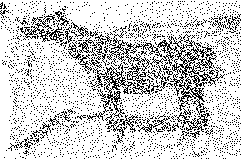
Usecase: Build Encoder/Decoder based on LSTM as a reconstruction model.
Setup logger for verbose output.
from logging import getLogger, StreamHandler, NullHandler, DEBUG, ERROR
logger = getLogger("pydbm")
handler = StreamHandler()
handler.setLevel(DEBUG)
logger.setLevel(DEBUG)
logger.addHandler(handler)
Import Python and Cython modules for computation graphs.
# LSTM Graph which is-a `Synapse`.
from pydbm.synapse.recurrenttemporalgraph.lstm_graph import LSTMGraph as EncoderGraph
from pydbm.synapse.recurrenttemporalgraph.lstm_graph import LSTMGraph as DecoderGraph
Import Python and Cython modules of activation functions.
# Logistic Function as activation function.
from pydbm.activation.logistic_function import LogisticFunction
# Tanh Function as activation function.
from pydbm.activation.tanh_function import TanhFunction
Import Python and Cython modules for loss function.
# Loss function.
from pydbm.loss.mean_squared_error import MeanSquaredError
Import Python and Cython modules for optimizer.
# SGD as a optimizer.
from pydbm.optimization.optparams.sgd import SGD as EncoderSGD
from pydbm.optimization.optparams.sgd import SGD as DecoderSGD
If you want to use not Stochastic Gradient Descent(SGD) but Adam optimizer, import Adam.
# Adam as a optimizer.
from pydbm.optimization.optparams.adam import Adam as EncoderAdam
from pydbm.optimization.optparams.adam import Adam as DecoderAdam
Futhermore, import class for verification of function approximation.
# Verification.
from pydbm.verification.verificate_function_approximation import VerificateFunctionApproximation
The activation by softmax function can be verificated by VerificateSoftmax.
from pydbm.verification.verificate_softmax import VerificateSoftmax
And import LSTM Model and Encoder/Decoder schema.
# LSTM model.
from pydbm.rnn.lstm_model import LSTMModel as Encoder
from pydbm.rnn.lstm_model import LSTMModel as Decoder
# Encoder/Decoder
from pydbm.rnn.encoder_decoder_controller import EncoderDecoderController
Instantiate Encoder.
# Init.
encoder_graph = EncoderGraph()
# Activation function in LSTM.
encoder_graph.observed_activating_function = TanhFunction()
encoder_graph.input_gate_activating_function = LogisticFunction()
encoder_graph.forget_gate_activating_function = LogisticFunction()
encoder_graph.output_gate_activating_function = LogisticFunction()
encoder_graph.hidden_activating_function = TanhFunction()
encoder_graph.output_activating_function = LogisticFunction()
# Initialization strategy.
# This method initialize each weight matrices and biases in Gaussian distribution: `np.random.normal(size=hoge) * 0.01`.
encoder_graph.create_rnn_cells(
input_neuron_count=observed_arr.shape[-1],
hidden_neuron_count=200,
output_neuron_count=target_arr.shape[-1]
)
# Optimizer for Encoder.
encoder_opt_params = EncoderAdam()
encoder_opt_params.weight_limit = 0.5
encoder_opt_params.dropout_rate = 0.5
encoder = Encoder(
# Delegate `graph` to `LSTMModel`.
graph=encoder_graph,
# The number of epochs in mini-batch training.
epochs=100,
# The batch size.
batch_size=100,
# Learning rate.
learning_rate=1e-05,
# Attenuate the `learning_rate` by a factor of this value every `attenuate_epoch`.
learning_attenuate_rate=0.1,
# Attenuate the `learning_rate` by a factor of `learning_attenuate_rate` every `attenuate_epoch`.
attenuate_epoch=50,
# Refereed maxinum step `t` in BPTT. If `0`, this class referes all past data in BPTT.
bptt_tau=8,
# Size of Test data set. If this value is `0`, the validation will not be executed.
test_size_rate=0.3,
# Loss function.
computable_loss=MeanSquaredError(),
# Optimizer.
opt_params=encoder_opt_params,
# Verification function.
verificatable_result=VerificateFunctionApproximation(),
# Tolerance for the optimization.
# When the loss or score is not improving by at least tol
# for two consecutive iterations, convergence is considered
# to be reached and training stops.
tol=0.0
)
Instantiate Decoder.
# Init.
decoder_graph = DecoderGraph()
# Activation function in LSTM.
decoder_graph.observed_activating_function = TanhFunction()
decoder_graph.input_gate_activating_function = LogisticFunction()
decoder_graph.forget_gate_activating_function = LogisticFunction()
decoder_graph.output_gate_activating_function = LogisticFunction()
decoder_graph.hidden_activating_function = TanhFunction()
decoder_graph.output_activating_function = LogisticFunction()
# Initialization strategy.
# This method initialize each weight matrices and biases in Gaussian distribution: `np.random.normal(size=hoge) * 0.01`.
decoder_graph.create_rnn_cells(
input_neuron_count=200,
hidden_neuron_count=observed_arr.shape[-1],
output_neuron_count=200
)
# Optimizer for Decoder.
decoder_opt_params = DecoderAdam()
decoder_opt_params.weight_limit = 0.5
decoder_opt_params.dropout_rate = 0.5
decoder = Decoder(
# Delegate `graph` to `LSTMModel`.
graph=decoder_graph,
# The number of epochs in mini-batch training.
epochs=100,
# The batch size.
batch_size=100,
# Learning rate.
learning_rate=1e-05,
# Attenuate the `learning_rate` by a factor of this value every `attenuate_epoch`.
learning_attenuate_rate=0.1,
# Attenuate the `learning_rate` by a factor of `learning_attenuate_rate` every `attenuate_epoch`.
attenuate_epoch=50,
# Refereed maxinum step `t` in BPTT. If `0`, this class referes all past data in BPTT.
bptt_tau=8,
# Size of Test data set. If this value is `0`, the validation will not be executed.
test_size_rate=0.3,
# Loss function.
computable_loss=MeanSquaredError(),
# Optimizer.
opt_params=decoder_opt_params,
# Verification function.
verificatable_result=VerificateFunctionApproximation(),
# Tolerance for the optimization.
# When the loss or score is not improving by at least tol
# for two consecutive iterations, convergence is considered
# to be reached and training stops.
tol=0.0
)
Instantiate EncoderDecoderController and delegate encoder and decoder to this object.
encoder_decoder_controller = EncoderDecoderController(
# is-a LSTM model.
encoder=encoder,
# is-a LSTM model.
decoder=decoder,
# The number of epochs in mini-batch training.
epochs=200,
# The batch size.
batch_size=100,
# Learning rate.
learning_rate=1e-05,
# Attenuate the `learning_rate` by a factor of this value every `attenuate_epoch`.
learning_attenuate_rate=0.1,
# Attenuate the `learning_rate` by a factor of `learning_attenuate_rate` every `attenuate_epoch`.
attenuate_epoch=50,
# Size of Test data set. If this value is `0`, the validation will not be executed.
test_size_rate=0.3,
# Loss function.
computable_loss=MeanSquaredError(),
# Verification function.
verificatable_result=VerificateFunctionApproximation(),
# Tolerance for the optimization.
# When the loss or score is not improving by at least tol
# for two consecutive iterations, convergence is considered
# to be reached and training stops.
tol=0.0
)
Execute learning.
# Learning.
encoder_decoder_controller.learn(observed_arr, observed_arr)
This method can receive a np.ndarray of observed data points, which is a rank-3 array-like or sparse matrix of shape: (The number of samples, The length of cycle, The number of features), as the first and second argument. If the value of this second argument is not equivalent to the first argument and the shape is (The number of samples, The number of features), in other words, the rank is 2, the function of encoder_decoder_controller corresponds to a kind of Regression model.
After learning, the encoder_decoder_controller provides a function of inference method.
# Execute recursive learning.
inferenced_arr = encoder_decoder_controller.inference(test_arr)
The shape of test_arr and inferenced_arr are equivalent to observed_arr. Returned value inferenced_arr is generated by input parameter test_arr and can be considered as a decoded data points based on encoded test_arr.
On the other hand, the encoder_decoder_controller also stores the feature points in hidden layers. To extract this embedded data, call the method as follows.
feature_points_arr = encoder_decoder_controller.get_feature_points()
The shape of feature_points_arr is rank-2 array-like or sparse matrix: (The number of samples, The number of units in hidden layers). So this matrix also means time series data embedded as manifolds.
You can check the reconstruction error rate. Call get_reconstruct_error method as follow.
reconstruct_error_arr = dbm.get_reconstruction_error()
Usecase: Build Convolutional Auto-Encoder.
Setup logger for verbose output and import Python and Cython modules in the same manner as Usecase: Build Encoder/Decoder based on LSTM as a reconstruction model.
from logging import getLogger, StreamHandler, NullHandler, DEBUG, ERROR
logger = getLogger("pydbm")
handler = StreamHandler()
handler.setLevel(DEBUG)
logger.setLevel(DEBUG)
logger.addHandler(handler)
# ReLu Function as activation function.
from pydbm.activation.relu_function import ReLuFunction
# Tanh Function as activation function.
from pydbm.activation.tanh_function import TanhFunction
# Logistic Function as activation function.
from pydbm.activation.logistic_function import LogisticFunction
# Loss function.
from pydbm.loss.mean_squared_error import MeanSquaredError
# Adam as a optimizer.
from pydbm.optimization.optparams.adam import Adam
# Verification.
from pydbm.verification.verificate_function_approximation import VerificateFunctionApproximation
And import Python and Cython modules of the Convolutional Auto-Encoder.
# Controller of Convolutional Auto-Encoder
from pydbm.cnn.convolutionalneuralnetwork.convolutional_auto_encoder import ConvolutionalAutoEncoder
# First convolution layer.
from pydbm.cnn.layerablecnn.convolution_layer import ConvolutionLayer as ConvolutionLayer1
# Second convolution layer.
from pydbm.cnn.layerablecnn.convolution_layer import ConvolutionLayer as ConvolutionLayer2
# Computation graph for first convolution layer.
from pydbm.synapse.cnn_graph import CNNGraph as ConvGraph1
# Computation graph for second convolution layer.
from pydbm.synapse.cnn_graph import CNNGraph as ConvGraph2
Instantiate ConvolutionLayers, delegating CNNGraphs respectively.
# First convolution layer.
conv1 = ConvolutionLayer1(
# Computation graph for first convolution layer.
ConvGraph1(
# Logistic function as activation function.
activation_function=LogisticFunction(),
# The number of `filter`.
filter_num=20,
# The number of channel.
channel=1,
# The size of kernel.
kernel_size=3,
# The filter scale.
scale=0.1,
# The nubmer of stride.
stride=1,
# The number of zero-padding.
pad=1
)
)
# Second convolution layer.
conv2 = ConvolutionLayer2(
# Computation graph for second convolution layer.
ConvGraph2(
# Computation graph for second convolution layer.
activation_function=LogisticFunction(),
# The number of `filter`.
filter_num=1,
# The number of channel.
channel=20,
# The size of kernel.
kernel_size=3,
# The filter scale.
scale=0.1,
# The nubmer of stride.
stride=1,
# The number of zero-padding.
pad=1
)
)
Instantiate ConvolutionalAutoEncoder and setup parameters.
cnn = ConvolutionalAutoEncoder(
# The `list` of `ConvolutionLayer`.
layerable_cnn_list=[
conv1,
conv2
],
# The number of epochs in mini-batch training.
epochs=200,
# The batch size.
batch_size=100,
# Learning rate.
learning_rate=1e-05,
# Attenuate the `learning_rate` by a factor of this value every `attenuate_epoch`.
learning_attenuate_rate=0.1,
# Attenuate the `learning_rate` by a factor of `learning_attenuate_rate` every `attenuate_epoch`.
attenuate_epoch=50,
# Size of Test data set. If this value is `0`, the validation will not be executed.
test_size_rate=0.3,
# Optimizer.
opt_params=Adam(),
# Verification.
verificatable_result=VerificateFunctionApproximation(),
# The rate of dataset for test.
test_size_rate=0.3,
# Tolerance for the optimization.
# When the loss or score is not improving by at least tol
# for two consecutive iterations, convergence is considered
# to be reached and training stops.
tol=1e-15
)
Execute learning.
cnn.learn(img_arr, img_arr)
img_arr is a np.ndarray of image data, which is a rank-4 array-like or sparse matrix of shape: (The number of samples, The number of channel, Height of image, Width of image), as the first and second argument. If the value of this second argument is not equivalent to the first argument and the shape is (The number of samples, The number of features), in other words, the rank is 2, the function of cnn corresponds to a kind of Regression model.
After learning, the cnn provides a function of inference method.
result_arr = cnn.inference(test_img_arr[:100])
The shape of test_img_arr and result_arr is equivalent to img_arr.
References
- Ackley, D. H., Hinton, G. E., & Sejnowski, T. J. (1985). A learning algorithm for Boltzmann machines. Cognitive science, 9(1), 147-169.
- Boulanger-Lewandowski, N., Bengio, Y., & Vincent, P. (2012). Modeling temporal dependencies in high-dimensional sequences: Application to polyphonic music generation and transcription. arXiv preprint arXiv:1206.6392.
- Cho, K., Van Merriënboer, B., Gulcehre, C., Bahdanau, D., Bougares, F., Schwenk, H., & Bengio, Y. (2014). Learning phrase representations using RNN encoder-decoder for statistical machine translation. arXiv preprint arXiv:1406.1078.
- Dumoulin, V., & Visin, F. (2016). A guide to convolution arithmetic for deep learning. arXiv preprint arXiv:1603.07285.
- Eslami, S. A., Heess, N., Williams, C. K., & Winn, J. (2014). The shape boltzmann machine: a strong model of object shape. International Journal of Computer Vision, 107(2), 155-176.
- He, K., Zhang, X., Ren, S., & Sun, J. (2016). Deep residual learning for image recognition. In Proceedings of the IEEE conference on computer vision and pattern recognition (pp. 770-778).
- Hinton, G. E. (2002). Training products of experts by minimizing contrastive divergence. Neural computation, 14(8), 1771-1800.
- Kingma, D. P., & Ba, J. (2014). Adam: A method for stochastic optimization. arXiv preprint arXiv:1412.6980.
- Le Roux, N., & Bengio, Y. (2008). Representational power of restricted Boltzmann machines and deep belief networks. Neural computation, 20(6), 1631-1649.
- Lyu, Q., Wu, Z., Zhu, J., & Meng, H. (2015, June). Modelling High-Dimensional Sequences with LSTM-RTRBM: Application to Polyphonic Music Generation. In IJCAI (pp. 4138-4139).
- Lyu, Q., Wu, Z., & Zhu, J. (2015, October). Polyphonic music modelling with LSTM-RTRBM. In Proceedings of the 23rd ACM international conference on Multimedia (pp. 991-994). ACM.
- Malhotra, P., Ramakrishnan, A., Anand, G., Vig, L., Agarwal, P., & Shroff, G. (2016). LSTM-based encoder-decoder for multi-sensor anomaly detection. arXiv preprint arXiv:1607.00148.
- Masci, J., Meier, U., Cireşan, D., & Schmidhuber, J. (2011, June). Stacked convolutional auto-encoders for hierarchical feature extraction. In International Conference on Artificial Neural Networks (pp. 52-59). Springer, Berlin, Heidelberg.
- Salakhutdinov, R., & Hinton, G. E. (2009). Deep boltzmann machines. InInternational conference on artificial intelligence and statistics (pp. 448-455).
- Srivastava, N., Hinton, G., Krizhevsky, A., Sutskever, I., & Salakhutdinov, R. (2014). Dropout: a simple way to prevent neural networks from overfitting. The Journal of Machine Learning Research, 15(1), 1929-1958.
- Sutskever, I., Hinton, G. E., & Taylor, G. W. (2009). The recurrent temporal restricted boltzmann machine. In Advances in Neural Information Processing Systems (pp. 1601-1608).
- Zaremba, W., Sutskever, I., & Vinyals, O. (2014). Recurrent neural network regularization. arXiv preprint arXiv:1409.2329.
More detail demos
- Webクローラ型人工知能:キメラ・ネットワークの仕様 (Japanese)
- Implemented by the
C++version of this library, these 20001 bots are able to execute the dimensions reduction(or pre-training) for natural language processing to run as 20001 web-crawlers and 20001 web-scrapers.
- Implemented by the
- ハッカー倫理に準拠した人工知能のアーキテクチャ設計 (Japanese)
Related PoC
- Webクローラ型人工知能によるパラドックス探索暴露機能の社会進化論 (Japanese)
- 深層強化学習のベイズ主義的な情報探索に駆動された自然言語処理の意味論 (Japanese)
- ハッカー倫理に準拠した人工知能のアーキテクチャ設計 (Japanese)
- ヴァーチャルリアリティにおける動物的「身体」の物神崇拝的なユースケース (Japanese)
Author
- chimera0(RUM)
Author URI
License
- GNU General Public License v2.0
Project details
Release history Release notifications | RSS feed
Download files
Download the file for your platform. If you're not sure which to choose, learn more about installing packages.
Source Distribution
File details
Details for the file pydbm-1.3.5.linux-x86_64.tar.gz.
File metadata
- Download URL: pydbm-1.3.5.linux-x86_64.tar.gz
- Upload date:
- Size: 7.2 MB
- Tags: Source
- Uploaded using Trusted Publishing? No
- Uploaded via: twine/1.11.0 pkginfo/1.4.2 requests/2.18.4 setuptools/39.2.0 requests-toolbelt/0.8.0 tqdm/4.23.2 CPython/3.6.4
File hashes
| Algorithm | Hash digest | |
|---|---|---|
| SHA256 | 7276f1f7cd568d1953febe18e5d57840374d94d048ef7f291346a9a13aad7751 |
|
| MD5 | 52cda15e73b1bf0e393ca9eaa3a9a847 |
|
| BLAKE2b-256 | 2fc544708e6d6cc00addac72f133f3975f0c343899f466be2881d1e06e221fce |












